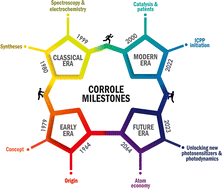Milestones in corrole chemistry: historical ligand syntheses and post-functionalization†
Abstract
Corroles are synthetic porphyrin analogs that contain one meso carbon atom lesser and bear a trianionic N4 metal-chelating core. They require in-depth preparative chemistry, demonstrate unique coordination chemistry and have impressive and diverse physical properties, and these are commonly compared to their respective porphyrins. The corrole's macrocyclic system is inherently electron rich and chelates metal ions in a more compact, less symmetric tetranitrogen cavity compared to that of porphyrins. Herein, we cover the highlights of the corrole research through the decades by first reviewing, in a chronological sense, multi-step syntheses; some routes have since been discontinued. This is followed by describing post-functionalization of already formed corroles via reactions performed on either the macrocycle's periphery or the inner nitrogen atoms or on the existing substituents. We do also mention milestones in literature reviewing, publication of encyclopedias, and the creation of professional organizations and conferences (ICPP) which make up the corrole/porphyrin research landscape. Also highlighted are still existing challenges and future perspectives.

- This article is part of the themed collection: Trends and Challenges in Porphyrinoid Chemistry


 Please wait while we load your content...
Please wait while we load your content...